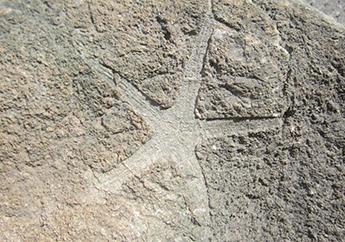Missouri Geological Survey Director: Carey Bridges, RG
Starfish, or sea stars, are a class of echinoderm, meaning “spinyskinned,” invertebrates that came into existence during the early part of the Paleozoic Era about 470 million years ago and have persisted to present day.
The name “starfish” alludes to their star-shaped bodies, which are composed of a central disc, from which five arms typically extend out in one plane. Some species have more arms.

Starfish have an internal skeleton that comprises numerous small pieces (ossicles) of calcium carbonate, in the form of the mineral calcite, that are held together by fibers of collagen. Outer surfaces of ossicles can be smooth, granular, warty or spiny. A starfish can open and close its underside along grooves located on each arm. These grooves, called ambulacral grooves, extend from tip of each arm to the middle of the central disk. The starfish’s mouth forms where the grooves converge. Sides of ambulacral grooves are lined with a row of tube feet, used by the starfish to move. The anus is on the top side, opposite the mouth. An eyespot is located on the tip of each arm.
Starfish are marine bottom dwellers that live in the intertidal zone to a depth of 20,000 feet. They crawl slowly on the seafloor and over objects using their tube feet. They can scale vertical sea cliffs. Maximum speed is 9 feet per minute.
Today, starfish are preyed upon by fish, crabs, large snails, gulls and sea otters. Starfish can regenerate arms that have been lost to predators. Remarkably, a severed arm can regenerate into a whole starfish. Most are predators of other bottom-dwelling organisms, such as clams, snails, sponges, corals, arthropods, small fish and even other starfish. Some do scavenge decomposing organic matter and fecal matter. They are capable of turning their stomach inside out from their mouth to aid in feeding.
Starfish belong to the Kingdom: Animalia; Phylum: Echinodermata (“Echinoderm” includes sea stars, brittle stars, sea urchins, sand dollars, sea cucumbers, crinoids, blastoids, etc.); and Class: Asteroidea (“Asteroid” means star-shaped). Approximately 1,500 species of starfish are alive today. The number of extinct species is unknown because few were preserved as fossils. Upon death, their bodies easily fall apart and the small ossicles were scattered by scavengers and ocean currents. The remains mixed with bottom sediment that eventually turned into rock. Fossils of whole starfish are rare.
Starfish and other fossils are on display in our Ed Clark Museum of Missouri Geology.
For more information
Geological Survey Program
Missouri Geological Survey
P.O. Box 250
Rolla, MO 65402-0250
United States
